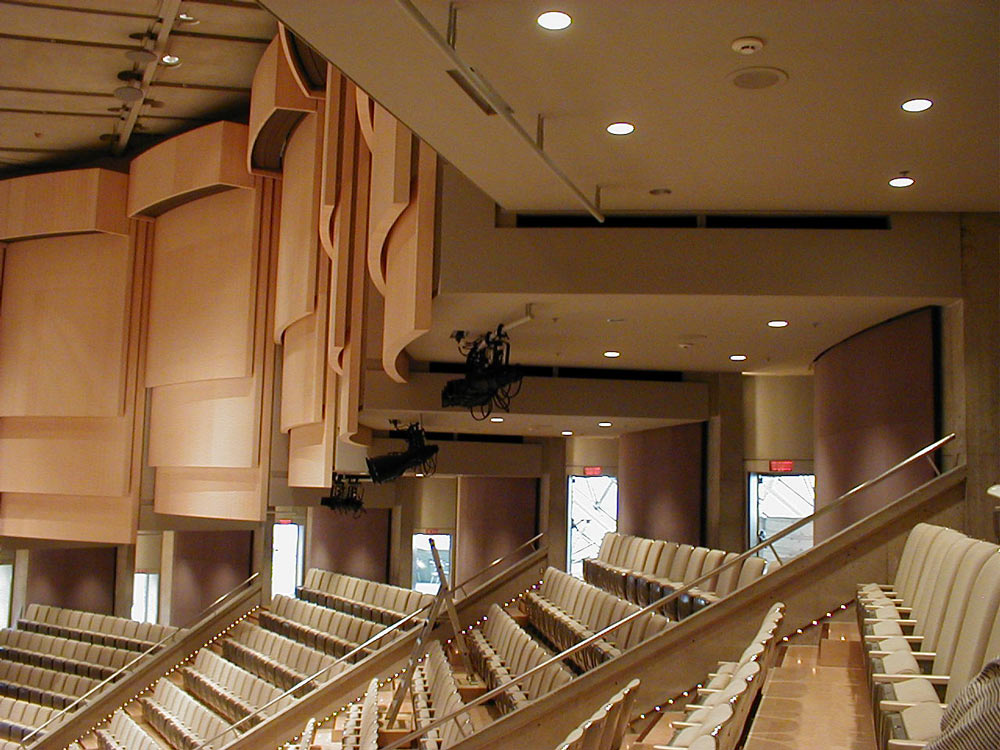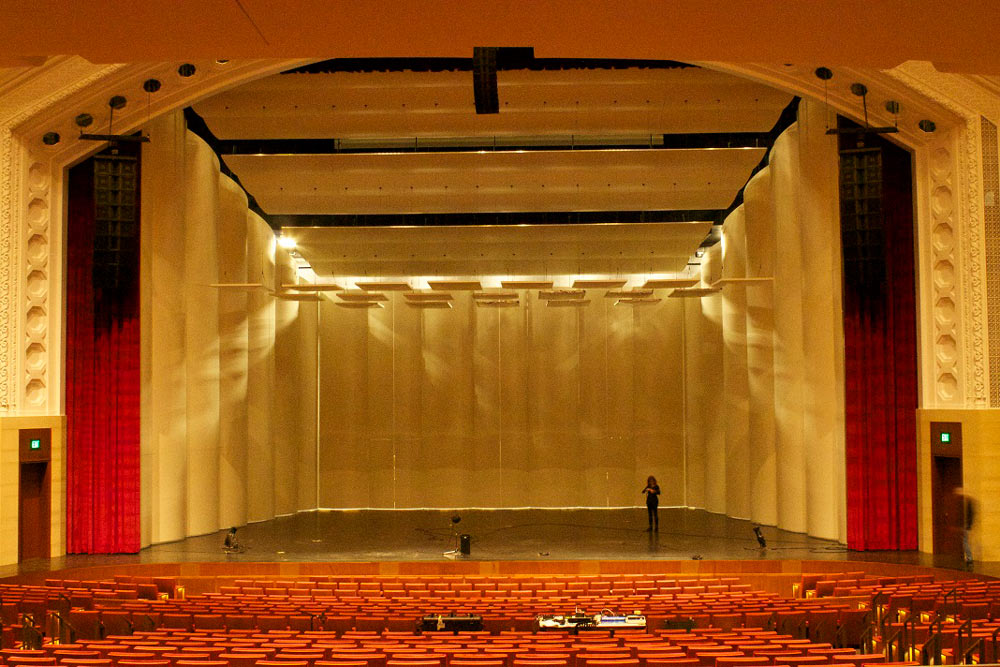Adjustable Acoustics
As theatre planning consultants, we frequently work with acousticians in the design of venues. How sound behaves and is perceived within a performing arts space is the purview of the acoustician. While there are many aspects of a design that acousticians will need to be engaged in, in general terms two of the acoustician’s primary concerns are:
- ensuring that a venue achieves an appropriate level for background noise by reducing noise from any mechanical or electrical systems and ground-borne vibration from exterior sources that could disturb performances, especially during pianissimo passages and quiet dramatic moments, and
- ensuring that sound created within the venue is distributed in space and time throughout the volume of the venue to satisfy the needs of performers and audience.
The project acoustician is the member of the design team who articulates these acoustical needs. The architect and the theatre planning consultant are the members of the design team who work with the acoustician to integrate many of these needs into the design of a venue. The acoustician has many factors to consider when determining how a venue must be designed to support the range of events that are planned, including total room volume, the distribution of the audience relative to the performance area, the reverberation characteristics of the venue, and the properties of the walls and ceiling such as their placement, orientation, shaping, construction, and finishes. Depending on the range of events envisioned for a given venue, the acoustician may suggest making some of the elements within a room adjustable. The theatre consultant and the architect participate in these conversations with the key stakeholders.
In general terms, unamplified music requires greater reverberance to allow individual notes to sustain and blend with other notes within the venue as they decay. Similarly, for pipe organ music a greater level of reverberance is desirable to allow for notes to blend. It is worth noting that these are aesthetic expectations that musicians and audiences have for unamplified orchestral or pipe organ music based on the spaces that these types of music have historically been composed for and played in.
For the presentation of unamplified dramatic speech, greater speech intelligibility is desirable, which requires less reverberance. This reduced reverberance allows for individual syllables to be clearly understood. Similarly, amplified sound and music, whether amplified musicals, pop music concerts, or cinema will be perceived as less muddied in a venue with less reverberance. Further, by reducing the reverberance, the buildup of amplified sound energy can be controlled to reduce the effects of excessive loudness.
Frequently, even if a new venue is intended to present primarily unamplified orchestral music, to be commercially viable, the venue may also need to be suitable for other types of events including conferences, lectures, cinema screenings, drama, and amplified music performance.
How is a venue to accommodate this range of performance types, each with its own acoustic needs?
When we consider adjustable acoustic treatments, there are three general types to bear in mind:
- Variable finishes and surface treatments
- Adjustability of the location or orientation of reflective surfaces
- Adjustability of the total volume of the venue
Variable Finishes and Surface Treatments
The most common adjustable acoustics feature is the deployment of sound absorbing materials into a venue, usually along perimeter walls but often also overhead. The result is that specific reflections that would otherwise reflect off walls can be minimized. Deployment of sound absorbing materials can be accomplished typically by using vertically deploying banners or horizontally deploying curtains. Acousticians will specify the type of fabric, the fabric’s weight, and how it is arranged relative to the perimeter walls adjacent to it, including the space around the fabric, to maximize its effect. The theatre consultant can then reserve zones for this fabric to deploy where it is needed and retract into dedicated spaces nearby when it is not needed. Part of this design process involves planning for the necessary machinery to drive these curtains and banners and safe access for technicians to service the machinery. Sometimes the acousticians will only want to deploy absorption in specific areas, while other times the acoustician may want to deploy as much absorption as possible to maximize its impact and create the greatest total change in reverberance.Other ways to alter wall finishes include deploying and retracting rigid sound absorbing panels into and out of a venue or rotating wall panels to reveal absorptive panels inside a venue. All these various means to deploy absorption into a room require planning and coordination during the design phases. The machinery required to actuate these adjustable acoustic treatments is typically specified by the theatre consultant and tendered as part of a theatre equipment package and must be fully coordinated to meet the needs of the architect and the acoustician.
Because deploying adjustable acoustic treatment along perimeter walls of a venue also changes the visual aesthetic of a venue, sometimes in coordination with an architect, a visual barrier can be placed in front of the adjustable acoustic treatment to preserve a constant visual aesthetic regardless of the state of the adjustable acoustic treatments. While no physical barriers can be purely “acoustically transparent”, sometimes acousticians may permit the use of these types of visual barriers such as screens, meshes, slats, etc., which can be acoustically transparent enough to have a minimal effect on the reverberance of the hall when the adjustable acoustic treatment are retracted. When these types of acoustically transparent barriers are used in a design, maintenance access must be provided to allow technicians to reach any mechanical components that drive the adjustable acoustic treatments. Theatre consultants typically coordinate with the architect and acoustician to provide maintenance access to these mechanical components.
Adjustability in the Location of Reflective Surfaces
As a venue is designed and walls and ceilings are located within the venue, the acoustician will work to understand how these surfaces will behave relative to the performers and the audience. It is critical both to enable musicians to hear themselves and the rest of their ensembles, and for the audience to hear a balanced mix of the music being performed.In concert halls, the location of overhead reflectors and side wall reflectors is important especially to provide critical early sound reflections for performers and audience. Sometimes overhead reflectors can be mechanically raised and lowered based on the size of the ensemble playing beneath them. To reflect sound effectively at a range of frequencies extending to low (bass) sound frequencies, overhead reflectors must have significant mass. This mass can make overhead reflectors weigh tens of tons in large concert halls. Sometimes overhead reflectors can be moved using winches located in an attic above the concert hall and sometimes these reflectors can be counterweighted and actuated by a winch that drives the counterweight.
Where proscenium theatres are intended to support concert music performance, acoustical reflectors can be incorporated into the design of the stage house and the rigging system. Sometimes these reflectors can be large and customized to deploy adjacent to or above the orchestra and retract into dedicated storage area either through mechanized or manual means, or there can also be multiple smaller reflectors that deploy to provide acoustical support to the musicians and to reflect unamplified sound to the audience. The theatre consultant is responsible for ensuring that these elements are integrated into the venue design, both to support the acoustic needs of the venue but also the theatrical functionality which may mean that these acoustic surfaces can be removed from the venue or stored out of the way of theatrical events which do not have need for them. The storage space and the machinery required to actuate these adjustable acoustic surfaces is typically specified by the theatre consultant and tendered as part of a theatre equipment package and must be fully coordinated to meet the needs of the project.
Adjustability in the Total Volume of the Venue

Adjustable ceiling canopy (red portion) above a concert hall. Aalborg House of Music, Denmark. (Photo Courtesy of Arup)
Control of Adjustable Acoustic Systems
One goal of all of these adjustable acoustic components is to provide the end user of the facility with simple control over the various systems whether they are banners, curtains, adjustable panels, overhead canopies, acoustic control chamber doors, etc., so that acoustic adjustments to a venue can be made easily to suit a given performance. Because theatre consultants typically specify the machinery that actuates these adjustable acoustic components, theatre consultants also specify the systems that control these components. Sometimes adjustable acoustic components can be simple, requiring only the manual force necessary to operate an acoustic curtain. When these adjustable acoustic components become more complicated and mechanized, the controls must allow users to move multiple components at one time while also providing the necessary safety features. The control systems required to operate these adjustable acoustic components, store settings, and recall presets are typically specified by the theatre consultant and tendered as part of a theatre equipment package.
A qualified acoustician will typically provide ample guidance to ensure a venue is able to satisfy the acoustic needs of the performers and audiences, to meet a desired acoustical environment. A theatre consultant can support the process by ensuring that all adjustable acoustic components are coordinated into the design and are able to be easily operated for the life of the venue. All must work together within the design team for a successful project.
By Michael Parrella, ASTC
Disclaimer: Any views or opinions expressed in this article are solely those of the author and do not necessarily represent those of the American Society of Theatre Consultants. This article is for general information only and should not be substituted for specific advice from a Theatre Consultant, Code Consultant, or Design Professional, and may not be suitable for all situations nor in all locations.





